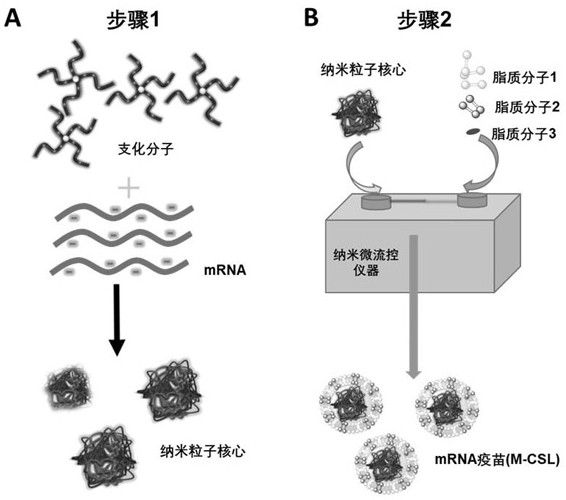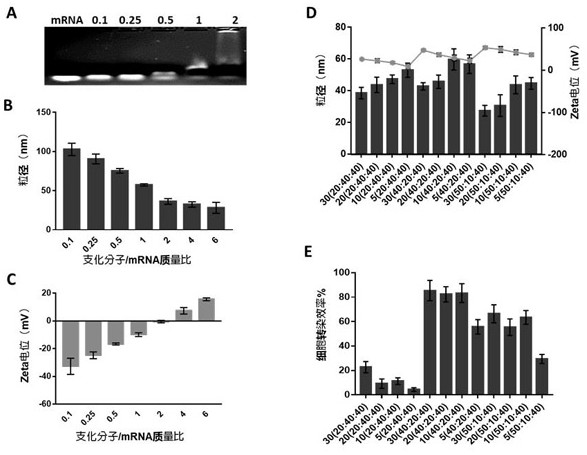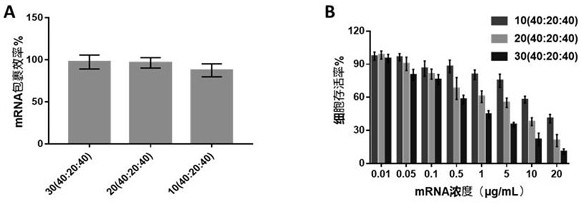Anti-tumor vaccine with core-shell structure containing branched polymer and mRNA and application of anti-tumor vaccine
A branched polymer, core-shell structure technology, applied in the field of biomedicine, can solve problems such as poor anti-tumor effect of vaccines
- Summary
- Abstract
- Description
- Claims
- Application Information
AI Technical Summary
Problems solved by technology
Method used
Image
Examples
Embodiment 1
[0059] Embodiment 1: the construction of branched polymer macromolecules:
[0060] Dissolve 0.2 g of a multi-arm initiator (such as PAMAMG0) in dry 100 ml of dimethylformamide, add 10 g of benzyl aspartate cyclic anhydride and stir at room temperature for 48 hours, then use diethyl ether to precipitate the product. In order to obtain a branched polymer macromolecule with a cation in the side chain, the obtained branched polyamino acid can be deprotected. Specifically, 1 g of the branched polymer macromolecule is dissolved in 10 ml of dimethyl sulfoxide, and the Wherein dropwise add the diethylenetriamine of 50 times than side group, react at room temperature for 1 hour and use hydrochloric acid to adjust the pH value of the solution to 2.0, then dialyze with distilled water and lyophilize to obtain cationic branched polymer macromolecule (specific reaction The process and structure are shown below).
[0061]
Embodiment 2
[0062] Embodiment 2: the composite of branched polymer macromolecule and mRNA:
[0063] Agarose gel electrophoresis: the synthesized branched polymer macromolecule and the mRNA segment encoding ovalbumin (OVA) were dissolved in distilled water and mixed according to different nitrogen-phosphorus ratios and stabilized at room temperature for 15 minutes ( figure 1 A), then the complex was added to an agarose gel with a mass percent concentration of 2% and operated at 80V for 30 minutes, and then the gel was stained with ethidium bromide and analyzed using ChemDoc TM It was imaged with the MP gel imaging system (Bio-Rad). The result is as figure 2 As shown in A, when the nitrogen to phosphorus ratio is greater than 1, the mRNA is completely encapsulated by the branched polymer macromolecules.
[0064] Particle size potential: The synthesized branched polymer macromolecules and mRNA were dissolved in distilled water and mixed according to different nitrogen to phosphorus ratio...
Embodiment 3
[0069] Example 3: Evaluation of nucleocapsid structure on mRNA encapsulation efficiency and in vitro toxicity:
[0070] Disperse the composite nanoparticles of branched polymer macromolecules prepared according to different nitrogen-phosphorus ratios and mRNA of known concentration in RNase-free water to make solution A, set the volume to 0.1ml to 10ml, and the mRNA concentration is 1μg / ml to 100 μg / ml; the above optimal ratio of lipid molecules such as (2,3-dioleoyl-propyl)-trimethylamine, dipalmitoylphosphatidylcholine and cholesterol in ethanol solution 40:20:40 (wt: wt) to prepare solution B, and finally adjust the volume to 0.1ml to 10ml. Using Nanoassemblr TM Mix solution A with solution B at a mixing flow rate from 0.1ml / min to 10ml / min. After preparation, the filtrate was collected by ultrafiltration and centrifugation, and the residual mRNA in the filtrate was determined using the Ribo Green kit. The calculation formula for the encapsulation efficiency of mRNA is as...
PUM
| Property | Measurement | Unit |
|---|---|---|
| Granularity | aaaaa | aaaaa |
| Electric potential | aaaaa | aaaaa |
Abstract
Description
Claims
Application Information
 Login to View More
Login to View More - R&D
- Intellectual Property
- Life Sciences
- Materials
- Tech Scout
- Unparalleled Data Quality
- Higher Quality Content
- 60% Fewer Hallucinations
Browse by: Latest US Patents, China's latest patents, Technical Efficacy Thesaurus, Application Domain, Technology Topic, Popular Technical Reports.
© 2025 PatSnap. All rights reserved.Legal|Privacy policy|Modern Slavery Act Transparency Statement|Sitemap|About US| Contact US: help@patsnap.com



